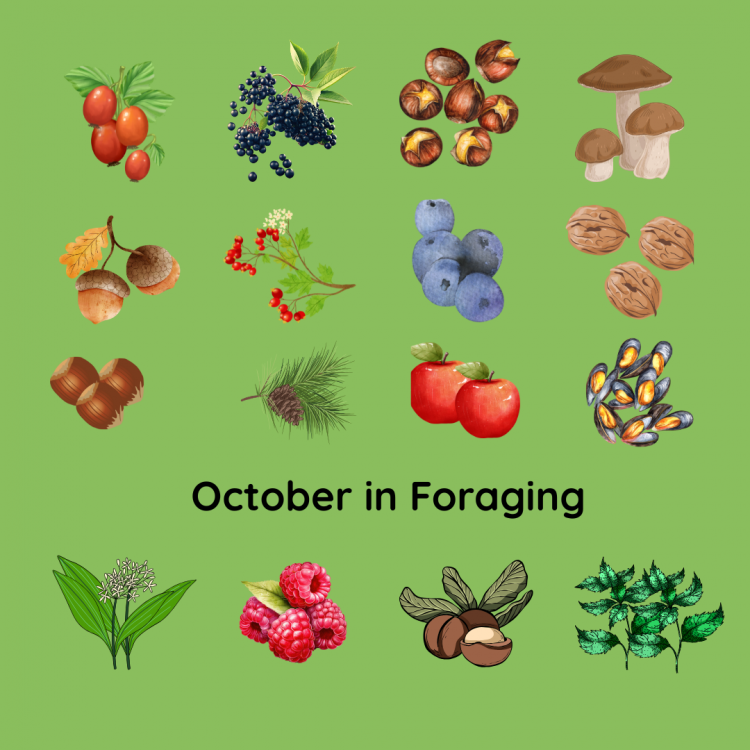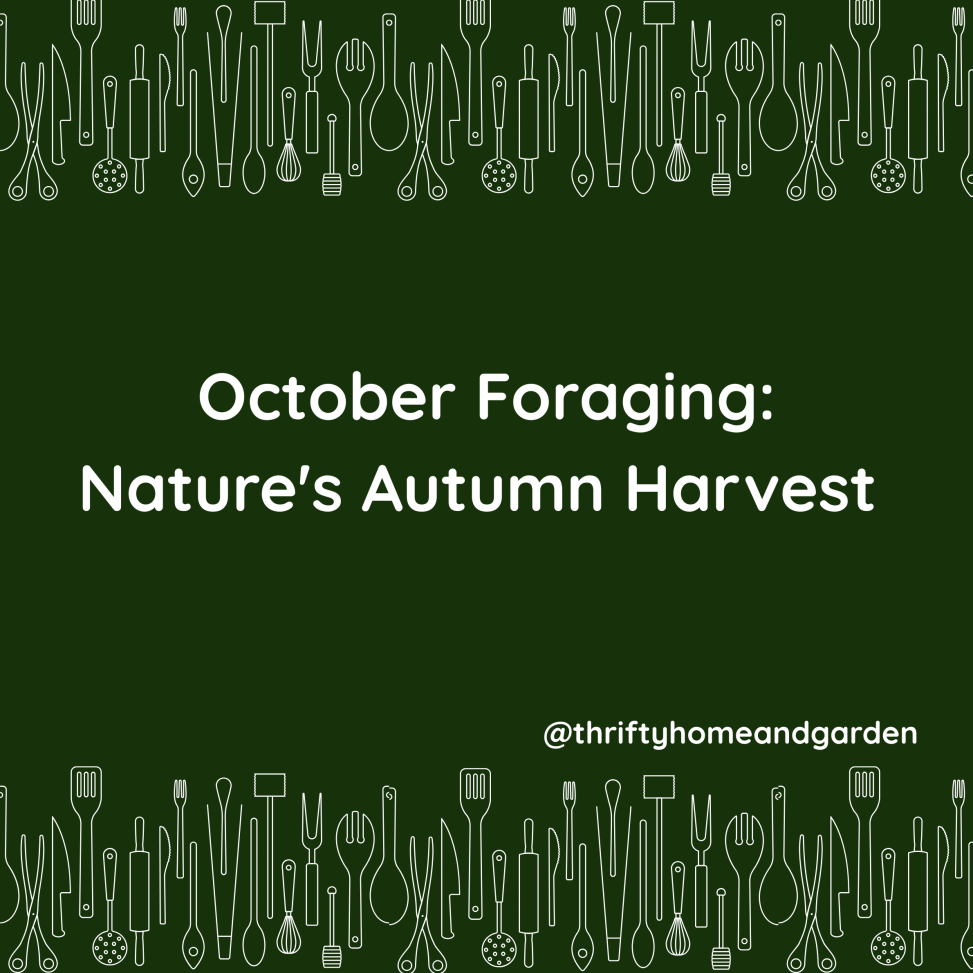October paints the British countryside in spectacular hues of amber, crimson and gold, but beneath this visual feast lies another treasure waiting to be discovered. As the leaves begin their graceful descent and the air carries the crisp promise of winter, nature offers her final generous bounty of the year. This is the season when ancient traditions come alive, and foragers across the UK venture forth to gather the wild edibles that have sustained communities for centuries.
Foraging represents far more than simply collecting free food from the wild. It connects us to the rhythms of the natural world, teaching us to observe seasonal changes with heightened awareness and appreciate the remarkable diversity that flourishes in our hedgerows, woodlands and meadows. October stands as one of the most rewarding months for this ancient practice, when fungi emerge from their hidden networks, berries reach peak ripeness, and nuts fall heavy from their branches.
The art of foraging requires knowledge, respect, and responsibility. Understanding not only what to collect but when, where, and how much ensures that we harvest sustainably, leaving ecosystems undisturbed for future generations. October’s offerings are particularly generous, providing everything from protein-rich nuts to vitamin-packed berries, each with their own unique flavours and traditional uses.

What is Foraging?
Foraging involves the systematic collection of wild plants, fungi, fruits and nuts for food, medicine or craft purposes. This practice stretches back to humanity’s earliest days, when our ancestors relied entirely on their knowledge of local flora to survive. Before agriculture transformed human civilisation, foraging skills meant the difference between feast and famine.
Modern foraging has evolved into both a practical skill and a mindful hobby. Contemporary foragers seek to reconnect with nature, reduce food waste, discover unique flavours, and develop a deeper understanding of local ecosystems. The practice demands botanical knowledge, seasonal awareness, and a strong ethical foundation based on sustainable harvesting principles.
Successful foraging requires understanding the “forager’s code”: never take more than one-third of what you find, avoid harvesting rare species, obtain permission when foraging on private land, and always leave the roots intact to ensure regeneration. These principles ensure that wild populations remain healthy and productive for years to come.
October’s Wild Harvest: Ten Treasures from Nature
1. Sweet Chestnuts (Castanea sativa)
Sweet chestnuts announce their readiness with a satisfying thud as they fall from towering trees that can live for over 600 years. These glossy, mahogany-coloured nuts nestle within spiky green husks called cupules, which split open to reveal their precious contents. Originally introduced by the Romans, sweet chestnuts have naturalised beautifully across southern England and Wales, thriving in well-drained, acidic soils.
The nuts themselves are kidney-shaped with a distinctive pointed end and glossy brown shell. Unlike horse chestnuts, which are toxic, sweet chestnuts are smaller, more triangular, and emerge from husks covered in long, branching spines rather than short, thick ones.
Uses and Benefits: Sweet chestnuts provide excellent carbohydrates, healthy fats, vitamin C, and potassium. Their sweet, nutty flavour intensifies when roasted, making them perfect for both sweet and savoury applications.
Recipe Ideas: Score an X into each chestnut shell and roast at 200°C for 15-20 minutes until shells split open. Use in stuffings, soups, or purees. Try making chestnut flour by grinding dried chestnuts, perfect for gluten-free baking.
Disadvantages: Raw chestnuts are difficult to digest and may cause stomach upset. The spiky husks can be painful to handle without gloves, and harvesting requires careful identification to avoid confusion with toxic horse chestnuts.
2. Sloes (Prunus spinosa)
Sloes are the fruit of the blackthorn bush, appearing as small, dark purple berries with a distinctive blue-white bloom coating their skin. These hardy shrubs form dense, thorny thickets across heathland, woodland edges, and hedgerows throughout the UK. The berries ripen throughout October, reaching their peak after the first frosts, which help break down their astringent compounds.
Blackthorn bushes are easily recognisable by their vicious thorns, small oval leaves, and clusters of white flowers that appear in early spring before the leaves emerge. The berries measure roughly 1-1.5cm in diameter and contain a single large stone.
Uses and Benefits: Sloes are incredibly rich in vitamin C, antioxidants, and tannins. While too astringent to eat raw, they transform beautifully when processed, offering anti-inflammatory and digestive benefits.
Recipe Ideas: The classic sloe gin requires 500g sloes, 250g caster sugar, and 750ml gin, left to mature for at least three months. Create sloe jelly by simmering the berries with apples for natural pectin. Sloe vodka offers a smoother alternative to gin, while sloe vinegar adds complexity to salad dressings.
Disadvantages: The intense astringency makes raw sloes virtually inedible, causing severe mouth puckering. The thorns are exceptionally sharp and can cause deep puncture wounds, making harvesting challenging even with thick gloves.
3. Rosehips (Rosa species)
Rosehips are the vibrant orange-red fruits that develop after wild roses finish flowering, reaching peak ripeness throughout October. These oval to round fruits vary in size depending on the species, with dog rose (Rosa canina) producing the largest and most abundant crops. The bushes themselves display distinctive arching stems, compound leaves with serrated edges, and the remnants of five-petaled flowers at the hip’s base.
Native rose species produce the most flavourful and nutritious hips, easily distinguished from cultivated varieties by their simpler flower structure and more intense fruit flavour. The hips feel firm but yield slightly to pressure when ripe.
Uses and Benefits: Rosehips contain 20 times more vitamin C than oranges, plus vitamins A, E, and K, along with powerful antioxidants and pectin. They support immune function and provide anti-inflammatory compounds.
Recipe Ideas: Remove seeds and simmer hips with minimal water to create rosehip syrup, excellent for flavouring desserts or mixing with water as a healthy drink. Rosehip jelly pairs wonderfully with game meats, while dried rosehips make caffeine-free herbal tea. Try rosehip and apple chutney for a unique preserve.
Disadvantages: The seeds inside rosehips are covered in irritating hairs that can cause severe discomfort if consumed, requiring careful removal through sieving. Processing is time-consuming, and the fruit’s tartness requires sweetening for most palates.
4. Hawthorn Berries (Crataegus monogyna)
Hawthorn berries, traditionally called “haws,” cluster in dense bunches on thorny shrubs and small trees found throughout British landscapes. These deep red berries ripen in October, each containing a single large seed and offering a distinctive sweet-tart flavour reminiscent of over-ripe apples.
Hawthorn trees are easily identified by their deeply lobed leaves, clusters of white flowers in spring, and formidable thorns. The berries measure 8-14mm across and turn from green through red to deep crimson as they ripen.
Uses and Benefits: Rich in antioxidants, vitamins C and B, and compounds that support cardiovascular health, hawthorn berries have been used medicinally for centuries. They’re particularly valued for heart and circulation support.
Recipe Ideas: Create hawthorn berry leather by simmering berries until soft, passing through a sieve to remove seeds, then dehydrating the pulp. Hawthorn jelly makes an excellent accompaniment to cheese and cold meats. Try fermenting the berries into a mildly alcoholic country wine, or dry them for herbal teas.
Disadvantages: The large seeds make processing laborious, and consuming large quantities may cause mild stomach upset in sensitive individuals. The thorns make harvesting challenging and potentially dangerous.
5. Crab Apples (Malus sylvestris)
Wild crab apples dangle from ancient trees that have survived in woodlands, hedgerows, and commons across Britain for thousands of years. These small, typically yellow-green fruits with red blushing ripen throughout October, ranging from marble-sized to small plum dimensions depending on the variety.
True wild crab apple trees display smaller, more angular leaves than domestic varieties, with fruits that remain small and intensely sour even when fully ripe. The bark is typically grey-brown and often develops distinctive flaking patterns with age.
Uses and Benefits: Exceptionally high in pectin, making them ideal for preserves, crab apples also provide vitamin C, antioxidants and malic acid. They’re particularly valuable for their natural preservation properties.
Recipe Ideas: Crab apple jelly is the classic preparation—simmer whole fruits until soft, strain through muslin, then boil the clear juice with sugar. Create crab apple vinegar for gourmet cooking, or use them to add natural pectin to other fruit preserves. Roasted crab apples make an interesting accompaniment to pork dishes.
Disadvantages: The intense sourness makes them inedible raw for most people, and the small size means significant labour for minimal yield. Some varieties can be particularly astringent, causing mouth discomfort.
6. Elderberries (Sambucus canadensis)
Elderberries form distinctive flat-topped clusters of tiny, dark purple-black berries on tall shrubs with distinctive compound leaves. By October, these berries have reached full ripeness, hanging heavy on their red stems and filling the air with their characteristic musky-sweet aroma.
Elder shrubs are unmistakable with their opposite, pinnate leaves consisting of 5-7 serrated leaflets, and their berries arranged in large, flat corymbs. The berries themselves are roughly 6mm across and contain 2-3 small seeds each.
Uses and Benefits: Packed with anthocyanins, vitamin C, and immune-supporting compounds, elderberries have been used medicinally for centuries to combat colds and flu. They also provide potassium, folate, and powerful antioxidants.
Recipe Ideas: Elderberry syrup is made by simmering berries with minimal water, straining, then adding honey or sugar. This can be taken medicinally or used to flavour desserts. Create elderberry wine, jelly or cordial. Elderberries also work well in pies when combined with apples to balance their intense flavour.
Disadvantages: Raw elderberries can cause nausea and digestive upset in some people, requiring cooking to neutralise potentially problematic compounds. The seeds are mildly toxic, though cooking renders them safe. Care must be taken to avoid red-berried elder species, which are toxic.
7. Walnuts (Juglans regia)
English walnuts, despite their name, were introduced by the Romans and have since naturalised in suitable locations across southern Britain. October sees these prized nuts falling from tall, stately trees, their green husks beginning to split and blacken as they reveal the familiar wrinkled shells within.
Walnut trees are magnificent specimens with smooth grey bark, compound leaves containing 7-9 leaflets, and distinctive aromatic properties—crushing the leaves releases a characteristic spicy scent that can identify the tree even from a distance.
Uses and Benefits: Walnuts provide healthy omega-3 fatty acids, protein, vitamin E, and minerals including magnesium and phosphorus. They support brain health, heart function, and provide sustained energy.
Recipe Ideas: Fresh walnuts can be eaten raw, pickled while young and soft, or incorporated into both sweet and savoury dishes. Try walnut bread, walnut pesto using wild garlic leaves, or traditional pickled walnuts made from young, soft nuts harvested in June. Walnut oil pressed from fresh nuts adds luxurious flavour to salads.
Disadvantages: The husks stain hands and clothing with persistent brown marks that are extremely difficult to remove. Some individuals experience allergic reactions, and the shells can be challenging to crack without proper tools. Fallen nuts may become rancid quickly if not collected promptly.
8. Bullace (Prunus domestica subsp. insititia)
Bullace are wild plums that ripen late in the season, often not reaching their peak until after the first October frosts. These small, round fruits typically measure 2-3cm across and range from yellow-green to dark purple, depending on the variety. They grow on thorny trees closely related to domestic plums but maintain their wild characteristics.
Bullace trees are smaller than cultivated plums, with more angular branching patterns and sharper thorns. The fruits have a distinctive bloom and contain proportionally larger stones than domestic varieties.
Uses and Benefits: Rich in vitamins C and K, potassium, and antioxidants, bullace provide natural fruit acids and pectin. They support digestive health and immune function while offering unique, complex flavours.
Recipe Ideas: Bullace jelly captures their distinctive flavour beautifully—cook until soft, strain, then set with sugar. Create bullace gin using the same method as sloe gin but with different proportions. They work excellently in crumbles when combined with apples, or can be made into a traditional country wine.
Disadvantages: Often extremely tart when raw, requiring cooking or processing to become palatable. The large stones relative to flesh make them labour-intensive to process, and yields can be disappointing. Trees may not fruit every year.
9. Beechnuts (Fagus sylvatica)
Beechnuts fall from majestic beech trees throughout October, their triangular brown nuts emerging from spiky four-sectioned cases called cupules. These small nuts, typically 12-15mm long, have sustained wildlife and humans for millennia, providing a reliable source of protein and oil.
Beech trees are among Britain’s most recognisable natives, with their smooth silver-grey bark, oval leaves with prominent parallel veins, and distinctive winter buds. The nuts themselves are three-sided with a pointed tip and glossy brown shell.
Uses and Benefits: Beechnuts contain high-quality protein, healthy fats, and B vitamins. They provide sustainable energy and essential amino acids, historically serving as both human food and animal feed during lean times.
Recipe Ideas: Roast beechnuts lightly to enhance their flavour and reduce any bitterness. Ground roasted beechnuts create a coffee substitute, while fresh nuts can be pressed for oil or ground into flour. They work well in stuffings or granola.
Disadvantages: Beechnuts can be mildly toxic in large quantities due to compounds that may cause digestive upset. The small size makes collection tedious, and yields vary dramatically between years. Some nuts may be bitter, requiring careful selection. You should not consume them raw or in large quantities, as they can cause mild stomach upset
10. Field Mushrooms (Agaricus campestris)
Field mushrooms emerge across grasslands, pastures, and meadows throughout October, often appearing in fairy rings or scattered groups after rainfall. These classic mushrooms closely resemble shop-bought varieties, with white caps, pink gills that turn dark brown with age, and distinctive white stems with simple rings.
Proper identification is crucial—look for the characteristic pink gills in young specimens, the pleasant mushroomy smell, and the yellow staining that occurs when the flesh is bruised. They typically grow 5-10cm across when mature.
Uses and Benefits: Field mushrooms provide protein, B vitamins, potassium, and selenium. They’re naturally low in calories while offering umami flavours and satisfying textures that enhance numerous dishes.
Recipe Ideas: Sauté field mushrooms simply with butter, garlic, and herbs to preserve their delicate flavour. They excel in risottos, pasta dishes, or classic mushroom soup. Try stuffed field mushrooms with breadcrumbs and herbs, or preserve them by drying for winter use.
Disadvantages: Mushroom identification requires extreme caution, as several toxic species can resemble field mushrooms. Maggot infestation is common, requiring careful inspection. They deteriorate rapidly after picking and must be used within a day or two.
Safety First: Essential Foraging Guidelines
Responsible foraging demands unwavering attention to safety and sustainability. Never eat anything unless you’re 100% certain of its identification—when in doubt, don’t risk it. Invest in reputable field guides, attend local foraging courses, and consider joining foraging groups where experienced practitioners can share their knowledge.
Always obtain permission before foraging on private land and respect protected areas where harvesting may be prohibited. Follow the one-third rule religiously, taking only what you need while leaving populations intact for wildlife and regeneration.
Be aware of pollution sources—avoid roadsides, industrial areas, and locations where chemicals might have been used. Some plants accumulate toxins from their environment, making location selection as important as species identification.
Embracing October’s Natural Abundance
October’s foraging opportunities connect us to ancestral wisdom while providing unique flavours and nutrients that money cannot buy. Each species offers its own rewards and challenges, teaching patience, observation and respect for the natural world that sustains us.
The journey from field to table requires dedication, but the rewards extend far beyond mere sustenance. Foraging develops botanical knowledge, seasonal awareness, and a profound appreciation for the intricate relationships that bind ecosystems together. Whether you’re crafting sloe gin for winter evenings, making rosehip syrup to boost immunity, or simply enjoying the meditative process of gathering nature’s gifts, October foraging offers experiences that enrich both body and soul.
As you venture forth into autumn’s golden landscape, carry with you the knowledge that countless generations have walked these same paths, gathering these same treasures. In continuing this ancient tradition, you become part of an unbroken chain connecting past to present, human to nature and sustenance to celebration.
Further Reading: Foraging Elderberries, Rose Hips: Autumn’s Ruby Treasures, Autumn’s Jewel: The Hawthorn Berry, Autumn Foraging: Nature’s Harvest, Apple Day: Celebrating Britain’s Fruit Heritage,






